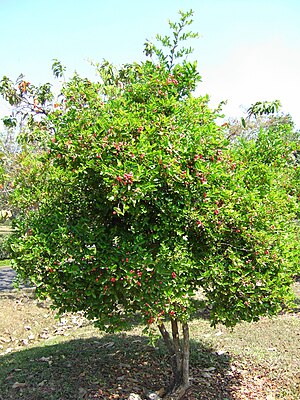Carissa Carandas
| Carissa Carandas | ||||||||||||
|---|---|---|---|---|---|---|---|---|---|---|---|---|

Carissa Carandas |
||||||||||||
| Systematics | ||||||||||||
|
||||||||||||
| Scientific name | ||||||||||||
| Carissa Carandas | ||||||||||||
| L. |
Carissa carandas is a species of wax tree ( Carissa ) inthe dog venom family (Apocynaceae). Thefruits called Karanda are edible.
description
Appearance and leaf
Carissa carandas grows as an evergreen , climbing or independently upright shrub or small tree that can reach heights of up to 5 meters. On the branches there are up to 5 cm long, paired, simple or forked, sharp thorns . The plant parts contain a sticky milky sap (latex). The brown bark is thick and furrowed.
The oppositely arranged, whole-margined leaves are short stalked. The dark green, leathery, simple leaf blades are 3 to 7.5 cm long and 1.5 to 4 cm wide, ovoid to rounded or ovate to oblong or obovate with a pointed to rounded blade base and rounded to pointed, pointed or round-pointed to indented upper end. There are about eight pairs of lateral nerves. The top of the leaf is glossy.
Inflorescence and flowers
The flowering period in China extends from March to June. At the end of 1.5 to 2.5 cm long inflorescence shafts there are usually only 3–12 flowers in zymous inflorescences . The cover sheets (Brakteolen) are tiny. The flower stalks are about as long or longer as the calyx.
The fragrant flowers are hermaphroditic and five-fold with a double flower envelope . The five small, 2.5 to 7 mm long, red and pointed sepals have many glands on the inside at their base. The red to white to light pink petals are fused tubular over a length of up to 2 cm. The red, long corolla tube is hairy inside. The five lanceolate corolla lobes with a length of about 1 cm end pointy and overlap to the left; they are downy hairy and ciliate. Two carpels are an above-permanent, two-chambered ovary grown. There are many ovules in each ovary chamber . The five short stamens at the top of the corolla tube are included.
fruit
The reddish at maturity to red or black-violet, mehrsamigen smooth and berries , with a thin, tough, fine whitish dotted shell, are at a length of 1.5 to 2.5 cm and a diameter of 1 to 2 cm circular to ellipsoid. The taste of the more or less sour flesh is reddish and very juicy. They contain milk juice. The fruits ripen in China between July and December. It contains up to 8 flattened, brown seeds.
Chromosome number
The number of chromosomes is 2n = 22.
distribution
The distribution area of Carissa carandas includes India , Sri Lanka , Myanmar , Cambodia , Taiwan , the Chinese provinces of Fujian, Guangdong, Guizhou as well as Hainan, Thailand , Malaysia , Indonesia and the Philippines .
use
The fruits are eaten fresh as well as pickled. They are often used in cooking for chutneys , curries and desserts.
Taxonomy
The first publication of Carissa Carandas was carried out in 1767 by Carl Linnaeus , in Mantissa Plantarum , 1, p 52. synonyms for Carissa Carandas L. are: Arduina Carandas (L.) K.Schum. , Carissa congesta Wight , Damnacanthus esquirolii H.Lév.
swell
- Bingtao Li, Antony JM Leeuwenberg & David J. Middleton: Apocynaceae , Carissa carandas , p. 146 - online with the same text as the printed work , In: Wu Zheng-yi & Peter H. Raven (eds.): Flora of China , Volume 16 - Gentianaceae through Boraginaceae , Science Press and Missouri Botanical Garden Press, Beijing and St. Louis, 1995, ISBN 0-915279-33-9 (Description and Distribution Section).
Individual evidence
- ↑ Carissa carandas in the Agriculture Tribune, October 21, 2002.
- ↑ a b c d e f J. Morton Karanda , pp. 422-424, In: Julia F. Morton: Fruits of warm climates , Miami, 1987, online at New Crop at Purdue University .
- ↑ a b c d e f g h Bingtao Li, Antony JM Leeuwenberg & David J. Middleton: Apocynaceae , Carissa carandas , p. 146 - online with the same text as the printed work , In: Wu Zheng-yi & Peter H. Raven (ed. ): Flora of China , Volume 16 - Gentianaceae through Boraginaceae , Science Press and Missouri Botanical Garden Press, Beijing and St. Louis, 1995, ISBN 0-915279-33-9 .
- ↑ Carissa carandas at Tropicos.org. Missouri Botanical Garden, St. Louis
Web links
- Carissa carandas at Useful Tropical Plants

